Description
Context
- Lawrence Livermore National Laboratory in California announced that an experiment carried out in its National Ignition Facility has made a breakthrough in nuclear fusion research.
About the Experiment
- In the experiment, lasers were used to heat a small target or fuel pellets.
- These pellets containing deuterium and tritium fused and produced more energy.
- The team noted that they were able to achieve a yield of more than 1.3 megajoules.
- The megajoule of energy released in the experiment is indeed impressive in fusion terms, but in practice, this is equivalent to the energy required to boil a kettle.
Nuclear Fusion
- Nuclear fusion is defined as the combining of several small nuclei into one large nucleus with the subsequent release of huge amounts of energy.
- Nuclear fusion powers our sun and harnessing this fusion energy could provide an unlimited amount of renewable energy.
Nuclear Fission
- Fission is the process of splitting a nucleus in two.
- Inside each uranium fuel pellet, there are millions of uranium nuclei.
- When these nuclei are split, a huge amount of energy is released.
- Some of this energy is from radiation, but the biggest source is kinetic energy.
- This is the energy that produces heat inside a reactor, which in turn is used to generate steam, and ultimately creates electricity.
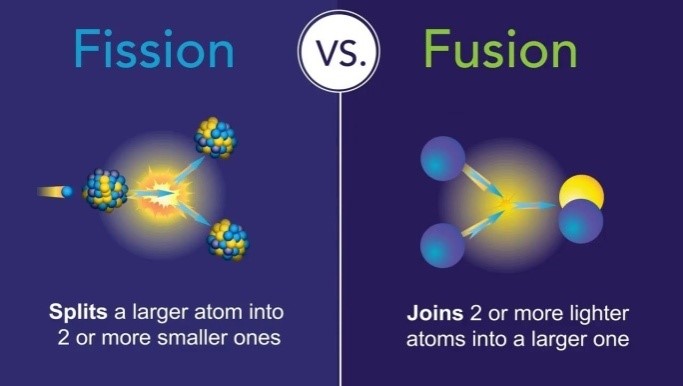

Why is fusion a better option than fission to generate power?
- Fusion is much better than fission in a number of ways. Firstly, nuclear fusion requires less fuel than fission.
- On top of that, fusion is carried out by using deuterium (an isotope of hydrogen) as fuel, which is quite abundant in nature.
- In contrast, the fuel necessary for fission (uranium, plutonium or thorium) is very hard to get – and highly expensive.
- Furthermore, unlike fission, nuclear fusion does not produce any radioactive waste; it only produces helium atoms as a byproduct, which we can actually use to our benefit in various ways.
- Since fusion doesn’t produce runaway chain reactions the way fission can, there’s practically no risk of a meltdown in the case of nuclear fusion.
Why don’t we use Nuclear Fusion then?
- For fusion to occur on Earth, we need a temperature of at least 100 million degrees Celsius—six times hotter than the core of the sun.
- The sun is a natural fusion reactor which makes up for its measly 15 million degrees with the intense pressure created by its core's gravity.
- Experimental fusion reactors do exist –– but they consume way more power than they produce, which basically defeats the purpose of generating power using fusion.
- It’s also quite difficult to find materials that can withstand the reaction.
- It requires a lot of excess energy in order to keep the fusion reaction going once it has started.
- Today, we conduct fusion reactions in a machine called the
- Recently, China’s “artificial sun” set a new record after it ran at 120 million degrees Celsius for 101 seconds, according to the state media.
- The Experimental Advanced Superconducting Tokamak (EAST) device designed by China replicates the nuclear fusion process carried out by the sun.
India’s Nuclear Share
- The share of nuclear power in the total electricity generation in the country is about 1 per cent in 2020-21 – Ministry of Science and Technology.
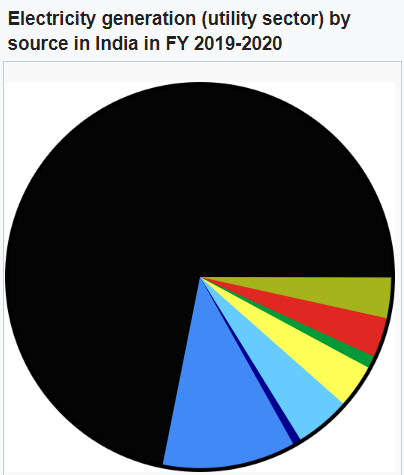
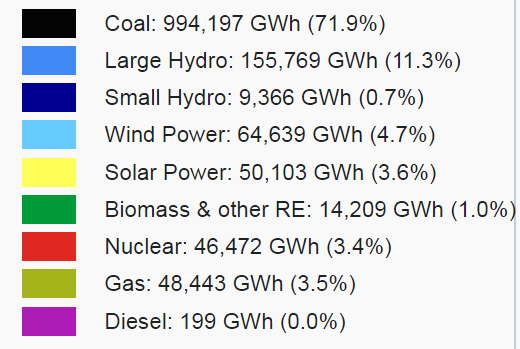
Nuclear Power in India
- Genesis: India's nuclear programme can trace its origins to 1944 and its efforts in 3 stage technology were established by Homi Jehangir Bhabha when he founded the nuclear research centre, the Tata Institute of Fundamental Research.
- Today, India has 23 nuclear reactors in operation in 7 nuclear power plants, with a total installed capacity of 7,480 MW.
- Nuclear power produced a total of 43 TWh in 2020-21, contributing 3.11% of total power generation in India (1,382 TWh).
- Kudankulam Nuclear Power Plant is the largest nuclear power station in India, situated in Tamil Nadu.
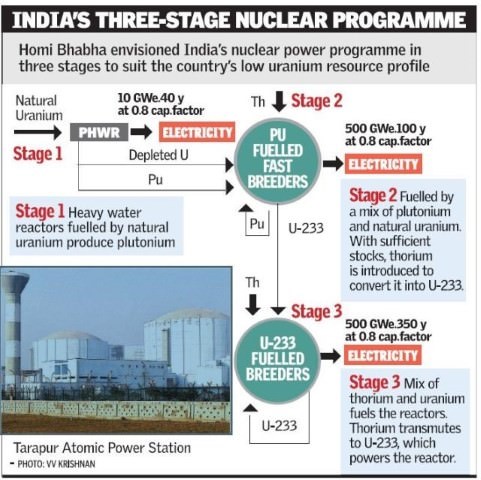
How does a Nuclear Power Plant Work?
- A nuclear reactor produces electricity in much the same way other power plants do.
- The chain reaction produces the energy, which turns water into steam.
- The pressure of the steam turns a generator, which produces electricity.
- The difference is in how the heat is created.
- Power plants that run on fossil fuels burn coal, oil or natural gas to generate heat.
- In a nuclear energy plant, heat is produced from splitting atoms – a process called nuclear fission.
- Nuclear reactor creates heat that is used to make steam
- The steam turns a turbine connected to an electromagnet, called a generator
- The generator produces electricity.
- Enriched uranium is the fuel for nuclear reactors.
- Uranium is an abundant, naturally radioactive element found in most rocks.
- As uranium breaks down or decays, it produces heat inside the Earth’s crust.
- A similar process generates heat inside a nuclear reactor.
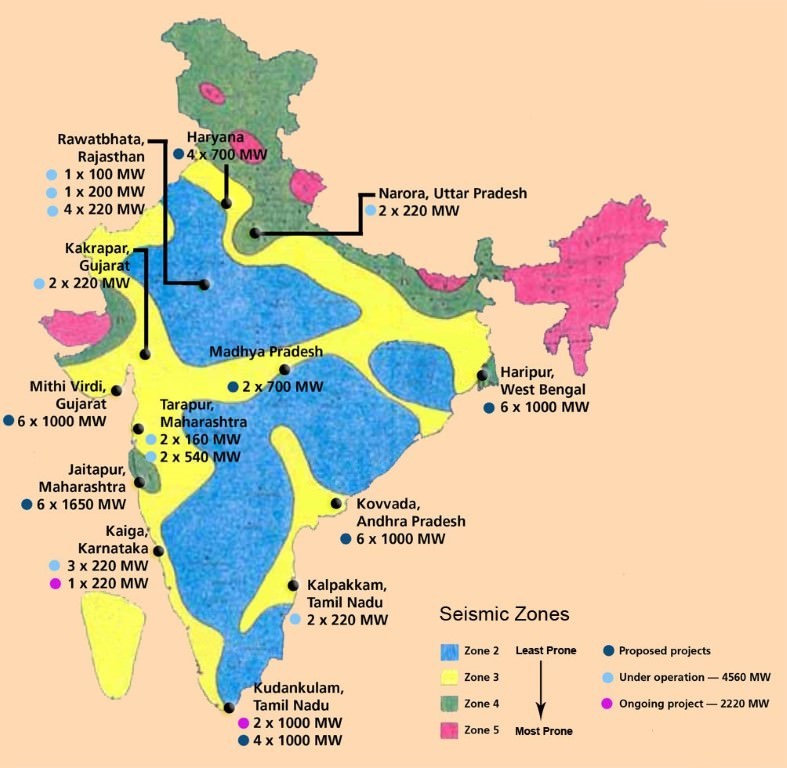
|
A pressurized heavy-water reactor (PHWR) is a nuclear reactor that uses heavy water (deuterium oxide D2O) as its coolant and neutron moderator. PHWRs frequently use natural uranium as fuel, but sometimes also use very low enriched uranium.
The PHWRs are also more efficient than comparable Light Water Reactor as they produce more energy per kilogram of mined uranium. These advantages make PHWRs ideal for India's nuclear energy programme. Opponents of PHWRs cite the high cost of heavy water as a drawback. Heavy water does occur naturally, however in much smaller quantities than regular water.
|
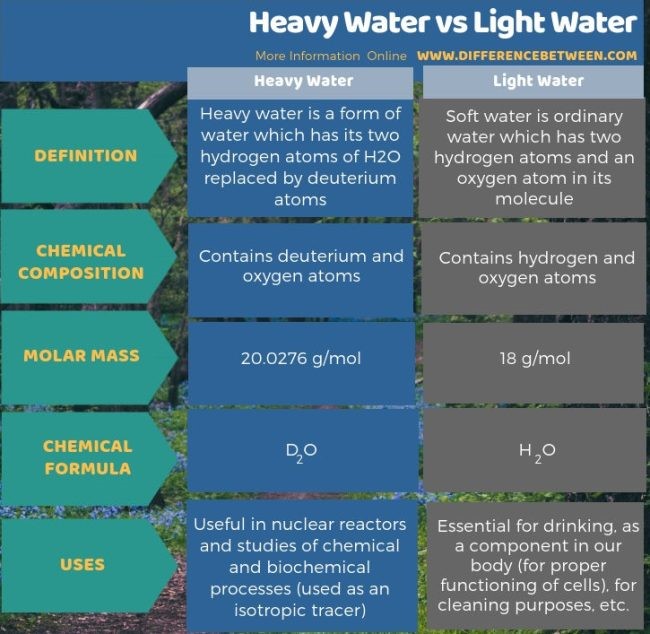
Nuclear Fuel Reserves
Uranium
- Found in Singhbhum and Hazaribagh districts of Jharkhand, and Gaya District of Bihar, and in sedimentary rocks of Saharanpur District of Uttar Pradesh.
- The largest source of uranium comprise the monazite sands, both beach and alluvial.
- Monazite sand rich in uranium is found in Kerala.
- Some uranium is found in the copper and zinc mines of Udaipur (Rajasthan).
- In 2011 large deposits of uranium were discovered in the Tummalapalle belt in Andhra Pradesh and in the Bhima basin in Karnataka.
- The Tummalapalle belt uranium reserves promises to be one of the world's top 20 uranium reserves discoveries.
- The total reserves of uranium as estimated by the Department of Atomic Energy, are about 31,000 tonnes.
- Kazakhstan is the largest supplier of uranium to India providing 5,000 tonnes during 2015-19.
- India also imports uranium fuel from Russia, Kazakhstan, Uzbekistan, France and Canada.
- Kazakhstan is the world's largest producer of uranium.
- In recent years, India has shown increased interest in thorium fuels
Thorium
- It is derived from monazite. It is produced in Kerala, Jharkhand, Bihar, Tamil Nadu, and Rajasthan.
- In addition to uranium and thorium, beryllium and lithium are also the atomic minerals found mainly in Jharkhand, Madhya Pradesh, and Rajasthan.
- India has vast thorium reserves and quite limited uranium reserves.
- Australia has the highest thorium resources followed by the US, Turkey and India.
|
Other Atomic Minerals found in India
Beryllium: Its reserves are in the states of Rajasthan, Jharkhand, Andhra Pradesh and Tamil Nadu.
Zircon: It is found mainly in the coastal sand of Kerala.
Antimony: It is found Himachal Pradesh and Madhya Pradesh.
Graphite: Odisha is the largest producer of graphite. Its largest reserve is in Ramanathpuram in Tamil Nadu. Its reserves are also in Jharkhand, Rajasthan and Andhra Pradesh.
|
Nuclear Energy around the world
- The USA is the world's largest producer of nuclear power, accounting for more than 30% of worldwide nuclear generation of electricity.
- The country's nuclear reactors produced 843 billion kWh in 2019, about 19% of total electrical output.
- Tokyo Electric Power Co.'s (TEPCO) Kashiwazaki-Kariwa plant in Japan is currently the world's largest nuclear power plant, with a net capacity of 7,965MW.
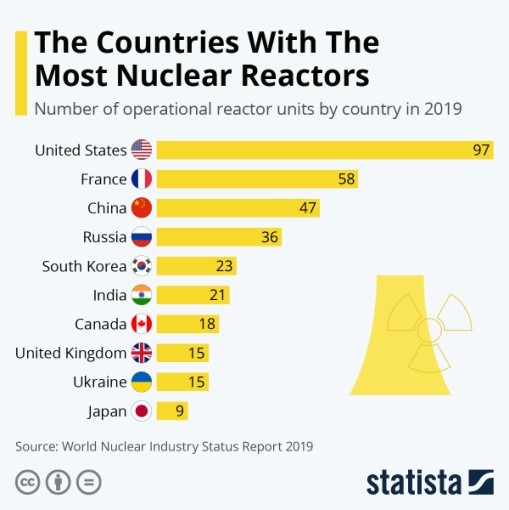
https://indianexpress.com/article/explained/nuclear-fusion-and-the-recent-breakthrough-7460081/




















